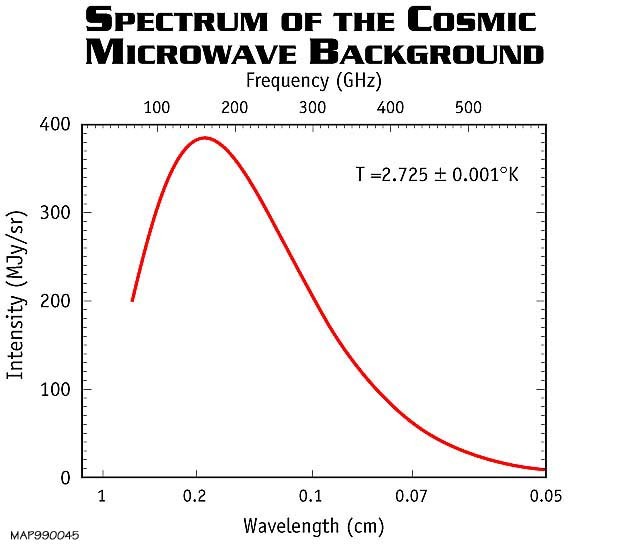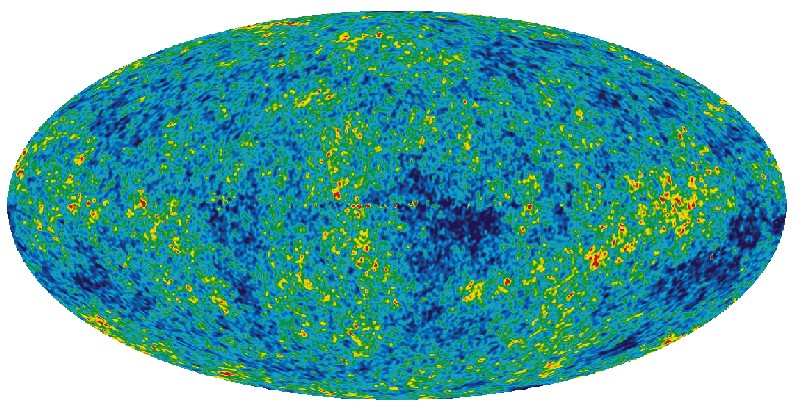
|
Main Topics > The Big Bang and the Big Crunch > Cosmic Background Radiation
The Ukrainian-American physicist George Gamow was the first to realize that, because the universe is all there is, the huge heat from a hot Big Bang could not dissipate in the same way as the heat from a regular explosion and therefore it must still be around today. Gamow's research students, Ralph Alpher and Robert Herman, moreover, argued in 1948 that, because the Big Bang effectively happened everywhere simultaneously, that energy should be equally spread as cosmic microwave background radiation (or CMB for short) throughout the universe. This radiation was emitted approximately 300,000 years after the Big Bang, before which time space was so hot that protons and electrons existed only as free ions, making the universe opaque to radiation. It should be visible today because, after this time, when temperatures fell to below about 3,000°K, ionized hydrogen and helium atoms were able to capture electrons, thus neutralizing their electric charge (known as “recombination”), and the universe finally became transparent to light. In 1965, Arno Penzias and Robert Wilson, two young employees of Bell Telephone Laboratories in New Jersey, discovered, although totally by accident, exactly that. The mysterious microwave static they picked up on their microwave antenna seemed to be coming equally from every direction in the sky, and eventually they realized that this microwave radiation (which has a temperature of about -270°C, marginally above absolute zero, and the coldest thing found in nature) must indeed be the “afterglow” of the Big Bang. Penzias and Wilson received the 1978 Nobel Prize in Physics for their discovery (although, strangely, Gamow’s contribution was never recognized).
It was later confirmed that the intensity of these microwaves at different wavelengths traces out a “black body” or “thermal” curve, consistent with radiation that has been brought into balance with its environment - just what would be expected if they were indeed a relic of an early hot “fireball” stage. This discovery, perhaps the most important cosmological discovery since Edwin Hubble had shown that we live in an expanding universe, was powerful evidence that our universe had indeed begun in a hot, dense state and had been growing and cooling ever since. The same photons that were around in the early stages of the Big Bang, then, have been propagating ever since, though growing fainter and less energetic as they fill a larger and larger universe. So ubiquitous is this cosmic microwave background radiation that, even though each cubic centimeter contains just 300 photons of it, in total it makes up 99% of all the photons in the universe (the remaining 1% being in starlight). It has been estimated that 1% of the “snow” which appears on a TV screen tuned between stations is attributable to cosmic background radiation!
In view of the importance of cosmic microwave background radiation to the Big Bang model of the universe (no other model has explained CMB quite so neatly), efforts were redoubled in an attempt to definitively prove the connection, first in the form of the Cosmic Background Explorer (COBE) satellite in 1989, and then the Wilkinson Microwave Anisotropy Probe (WMAP) in 2001. Both probes have confirmed the predicted data with increasing accuracy, as well as providing the most detailed picture we have of how the universe looked soon after the Big Bang, and establishing the age of the universe with much greater accuracy at 13.7 billion years. Another indirect indication that the universe began with a Big Bang is wrapped up in the very fact that the night sky we see from Earth is black. Olbers’ Paradox, named after the 19th Century German astronomer, Heinrich Wilhelm Olbers, who was one of the first to start to think of the universe as a whole. Olbers (who definitively stated the problem in 1823, although several others, dating back to the time of Newton, had previously posed similar ideas in various ways) asked why, if the universe was studded with billions upon billions of stars, the night sky was not completely lit up with the light from all these stars. The answer (first pointed out, interestingly enough, by the author Edgar Allen Poe in 1848) lies in the fact that the light from the more distant stars, in fact from the majority of the objects in the universe, has still to reach us. The only stars and galaxies we see are those close enough that their light has taken less than the 13.7 billion years since the Big Bang to reach us. For the same reason, the most distant objects visible (those recorded with sensitive equipment like the Hubble Space Telescope) appear to consist of much younger galaxies, only recently formed, or consisting mainly of glowing diffuse gas not yet fragmented into stars. Another apparent paradox is the question of why, given that the universe started off as much hotter than the center of the hottest star, all the primordial nuclei of hydrogen were not instantly transmuted into the tightly-bound and ultra-stable nuclei of iron (the final state of fusion process). In that case, no long-lived stars could ever have existed in our present universe as all the available fuel would have been used up in the initial fireball, and the universe as we know it would have been a non-starter. In fact, the ultra-hot conditions of the first few minutes of the expansion only lasted long enough to turn about 23% of the hydrogen into helium and tiny traces of lithium. It turns out that even the oldest objects in the universe contain about 23-24% of helium, and this confirms calculations which predict that hydrogen and helium are the only elements which would be created prolifically in a Big Bang event.
|
Back to Top of Page
Introduction | Main Topics | Important Dates and Discoveries | Important Scientists | Cosmological Theories | The Universe By Numbers | Glossary of Terms | A few random facts | Blog | Gravitational Lensing Animation | Angular Momentum Calculator | Big Bang Timeline
NASA Apps - iOS | Android
The articles on this site are © 2009-.
If you quote this material please be courteous and provide a link.
Citations | Sources | Privacy Policy

